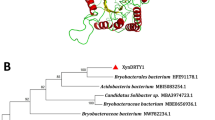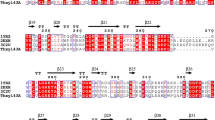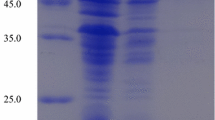Abstract
A xylanase gene (thxyn11A) from the Thermobifida halotolerans strain YIM 90462T was cloned and expressed in Escherichia coli. The open reading frame (ORF) of thxyn11A has 1,008 bp encoding a mature xylanase with a high degree of similarity (80 %) to the xylanase from Nocardiopsis dassonvillei subsp. dassonvillei DSM 43111. This enzyme (Thxyn11A) also possesses a glycosyl hydrolases family 11 (GH11) domain and a high isoelectric point (pI = 9.1). However, Thxyn11A varies from most GH11 xylanases, due to its large molecular mass (34 kDa). Recombinant Thxyn11A demonstrated a strong pH and temperature tolerance with a maximum activity at pH 9.0 and 70 °C. Xylotriose, the end-product of xylan hydrolysis by Thxyn11A, serves as a catalyst for hemicellulose pretreatment in industrial applications and can also function as a food source or supplement for enterobacteria. Due to its attractive biochemical properties, Thxyn11A may have potential value in many commercial applications.




Similar content being viewed by others
References
Abdul G, Sher AK, Zahid M, Muhammad IR, Farooq L (2011) Heterologous expression of a gene for thermostable xylanase from Chaetomium thermophilum in Pichia pastoris GS115. Mol Biol Rep 38:3227–3233
André RLD, Tony MS, Fausto BRA, Fábio MS, Daniela AR, Adriana FP, Fernando S, Rolf AP, João AJ, Hector FT, Maria LTMP (2011) Heterologous expression of an Aspergillus niveus xylanase GH11 in Aspergillus nidulans and its characterization and application. Process Biochem 46:1236–1242
Biely P (1985) Microbial xylanolytic systems. Trends Biotechnol 3:286–290
Bolam DN, Ciruela A, McQueen-Mason S, Simpson P, Williamson MP, Rixon JE, Boraston A, Hazlewood GP, Gilbert HJ (1998) Pseudomonas cellulose-binding domains mediate their effects by increasing enzyme substrate proximity. Biochem J 331:775–781
Collins T, Gerday C, Feller G (2005) Xylanases, xylanases families and extremophilic xylanases. FEMS Microbiol Rev 29:3–23
George EA, Anastasia Z, Panagiota MS, Kosmas H, George D, Amalia DK, Dimitris GH (2011) Homologous overexpression of xylanase in Fusarium oxysporum increases ethanol productivity during consolidated bioprocessing (CBP) of lignocellulosics. J Biotechnol 152:16–23
Henrissat B (1991) A classification of glycosyl hydrolasess based on amino acids similarities sequences. Biochem J 280:309–316
Huy ND, Kim SW, Park SM (2011) Heterologous expression of endo-1,4-beta-xylanase C from Phanerochaete chrysosporium in Pichia pastoris. J Biosci Bioeng 111:654–657
Kui H, Luo H, Shi P, Bai Y, Yuan T, Wang Y, Yang P, Dong S, Yao B (2010) Gene cloning, expression, and characterization of a thermostable xylanase from Nesterenkonia xinjiangensis CCTCC AA001025. Appl Biochem Biotechnol 162:953–965
Kulkarni N, Shendye A, Rao M (1999) Molecular and biotechnological aspects of xylanases. FEMS Microbiol Rev 23:411–456
Jeya M, Thiagarajan S, Lee JK, Gunasekaran P (2009) Cloning and expression of GH11 xylanase gene from Aspergillus fumigatus MKU1 in Pichia pastoris. J Biosci Bioeng 108:24–29
Jeya M, Thiagarajan S, Lee JK, Gunasekaran P (2009) Identification of new GH 10 and GH 11 xylanase genes from Aspergillus versicolor MKU3 by genome-walking PCR. Biotechnol Bioproc Eng 14:13–19
Lee CC, Kibblewhite-Accinelli RE, Smith MR, Wagschal K, Orts WJ, Wong DWS (2008) Cloning of Bacillus licheniformis xylanase gene and characterization of recombinant enzyme. Curr Microbiol 57:301–305
Li N, Shi P, Yang P, Wang Y, Luo H, Bai Y, Zhou Z, Yao B (2009) Cloning, expression, and characterization of a new Streptomyces sp. S27 xylanase for which xylobiose is the main hydrolysis product. Appl Biochem Biotechnol 159:521–531
Li WJ, Xu P, Schumann P, Zhang YQ, Pukall R, Xu LH, Stackebrandt E, Jiang CL (2007) Georgenia ruanii sp. nov., a novel actinobacterium isolated from forest soil in Yunnan (China), and emended description of the genus Georgenia. Int J Syst Evol Microbiol 57:1424–1428
Lineweaver H, Burk D (1934) The determination of enzyme dissociation constants. J Am Chem Soc 56:658–666
Liu SY, Shibu MA, Jhan HJ, Lo CT, Peng KC (2010) Purification and characterization of novel glucanases from Trichoderma harzianum ETS 323. J Agric Food Chem 58:10309–10314
Lorena AD, Teresa MC, Alejandro SH, Jesús VE, Farrés GSA, Beatriz XC, Roberto RM, María MH, María EHL (2010) Cloning and expression of a novel, moderately thermostable xylanase-encoding gene (Cfl xyn11A) from Cellulomonas flavigena. Bioresour Technol 101:5539–5545
Luo H, Wang Y, Li J, Wang H, Yang J, Yang Y, Huang H, Fan Y, Yao B (2009) Cloning, expression and characterization of a novel acidic xylanase, XYL11B, from the acidophilic fungus Bispora sp. MEY-1. Enzyme Microbial Technol 45:126–133
Miller GL (1959) Use of dinitrosalicylic acid reagent for determination of reducing sugar. Anal Chem 31:426–428
Qu W, Shao W (2011) Cloning, expression and characterization of glycoside hydrolases family 11 endoxylanase from Bacillus pumilus ARA. Biotechnol Lett 33:1407–1416
Ricardo SST, Félix GS, Marcelo VS, Edivaldo XFF, Elba PSB (2010) Purification and characterization studies of a thermostable β-xylanase from Aspergillus awamori. J Ind Microbiol Biotechnol 37:1041–1051
Sambrook J, Russell DW (2001) Molecular cloing: a laboratory manual, 3rd edn. Cold Spring Harbor, New York, Appendix A2.4
Shrinivas D, Savitha G, Raviranjan K, Naik GR (2010) A highly thermostable alkaline cellulase-free xylanase from thermoalkalophilic Bacillus sp. JB 99 suitable for paper and pulp industry: purification and characterization. Appl Biochem Biotechnol 162:2049–2057
Tan G, Gao Y, Shi M, Zhang X, He S, Chen Z, An C (2005) SiteFinding-PCR: a simple and efficient PCR method for chromosome walking. Nucleic Acids Res 33:e122
Thayat S, Peechapack S, Kenji M, Fusako K, Kosum C (2011) Cloning of a thermostable xylanase from Actinomadura sp. S14 and its expression in Escherichia coli and Pichia pastoris. J Biosci Bioeng 111:528–536
Thomson JA (1993) Molecular biology of xylan degradation. FEMS Microbiol Lett 104:65–82
Vazquez MJ, Alonso JL, Dominguez H, Parajo JC (2000) Xylooligosaccharides: manufacture and applications. Trends Food Sci Technol 11:387–393
Wang G, Luo H, Meng K, Wang Y, Huang H, Shi P, Pan X, Yang P, Diao Q, Zhang H, Yao B (2011) High genetic diversity and different distributions of glycosyl hydrolase family 10 and 11 xylanases in the goat rumen. PLoS ONE 6:e16731
Wang Q, Xia T (2008) Importance of C-terminal region for thermostability of GH11 xylanase from Streptomyces lividans. Appl Biochem Biotechnol 144:273–282
Yang LL, Tang SK, Zhang YQ, Zhi XY, Wang D, Xu LH, Li WJ (2008) Thermobifida halotolerans sp. nov., isolated from a salt mine sample, and emended description of the genus Thermobifida. Int J Syst Evol Microbiol 58:1821–1825
Zhang F, Chen JJ, Ren WZ, Nie GX, Ming H, Tang SK, Li WJ (2011) Cloning, expression and characterization of an alkaline thermostable GH9 endoglucanase from Thermobifida halotolerans YIM 90462T. Bioresour Technol 102:10143–10146
Zhang F, Hu SN, Chen JJ, Lin LB, Wei YL, Tang SK, Xu LH, Li WJ (2012) Purification and partial characterisation of a thermostable xylanase from salt-tolerant Thermobifida halotolerans YIM 90462T. Process Biochem 47:225–228
Zhao Y, Meng K, Luo H, Yang P, Shi P, Huang H, Bai Y, Yao B (2011) Cloning, expression, and characterization of a new xylanase from alkalophilic Paenibacillus sp. 12–11. J Microbiol Biotechnol 21:861–868
Zhou J, Shi P, Zhang R, Huang H, Meng K, Yang P, Yao B (2011) Symbiotic Streptomyces sp. TN119 GH 11 xylanase: a new pH-stable, protease- and SDS-resistant xylanase. J Ind Microbiol Biotechnol 38:523–530
Acknowledgments
We are grateful to Dr. Chao Huang for technological guidance on TLC and to Dr. Guang-Yu Yang for many useful discussions. This research was supported by the National Basic Research Program of China (No. 2010CB833801), the National Natural Science Foundation of China (No. 31070007), and the International Cooperation Research Program of Yunnan Province (No. 2009AC017). W-J Li was also supported by ‘Hundred Talents Program' of the Chinese Academy of Sciences.
Author information
Authors and Affiliations
Corresponding author
Rights and permissions
About this article
Cite this article
Zhang, F., Chen, JJ., Ren, WZ. et al. Cloning, expression, and characterization of an alkaline thermostable GH11 xylanase from Thermobifida halotolerans YIM 90462T . J Ind Microbiol Biotechnol 39, 1109–1116 (2012). https://doi.org/10.1007/s10295-012-1119-8
Received:
Accepted:
Published:
Issue Date:
DOI: https://doi.org/10.1007/s10295-012-1119-8




